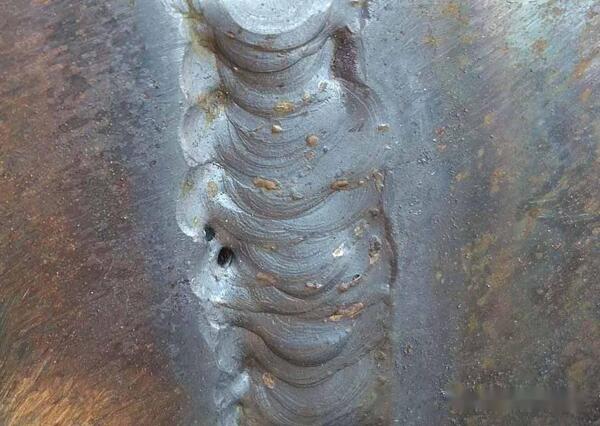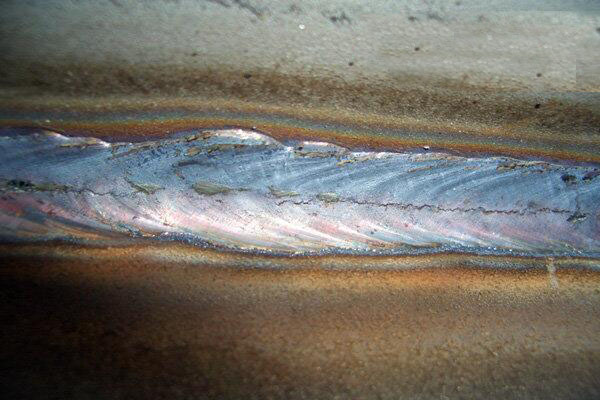
Common Defects and Preventive Measures of Weld Seam of Spiral Steel Pipe
PMC spiral steel pipe manufacturers analyze these defects and preventive measures from the perspective of ultrasonic flaw detection of spiral steel pipe welds.
1. Weld porosity
The echo height of a single stomata is low, and the waveform is a single slit, which is relatively stable. When detecting from all directions, the reflected wave is roughly the same, but it disappears when the probe is moved a little, and a cluster of reflected waves will appear in dense air holes. The wave height varies with the size of the air hole.

Causes of porosity:
The main reason is that the welding materials are not dried according to the specified temperature, the coating of the electrode is deteriorated and peeled off, the welding core is corroded, the welding wire is not cleaned cleanly, the current is too large and the arc is too long during manual welding; the voltage is too high or the network voltage fluctuates too much during submerged arc welding ; The purity of the shielding gas is low during gas shielded welding. If there are pores in the weld, it will not only destroy the compactness of the weld metal, but also reduce the effective cross-sectional area of the weld and reduce the mechanical properties. Especially when there are chain pores, the bending and impact toughness will be significantly reduced.
Preventive measures:
Do not use welding rods with cracked, peeling, deteriorated coatings and corroded cores. Rusty welding wires must be derusted before use. The welding materials used should be dried according to the specified temperature, the groove and both sides should be cleaned, and the appropriate welding current, arc voltage and welding speed should be selected.
2. Slag inclusion
The point-shaped slag-inclusion echo signal is similar to the point-shaped pore, and the strip-shaped slag-inclusion echo signal is mostly jagged with low amplitude, and the waveform is mostly dendritic. There are small peaks on the side of the main peak, and the amplitude of the probe translation changes. The reflection amplitudes are not the same.
Causes of slag inclusions:
The welding current is too small, the speed is too fast, the slag has no time to float, the welded edge and the welds of each layer are not cleaned, the chemical composition of the base metal and welding materials is improper, and there are more sulfur and phosphorus.
Preventive measures:
Correctly select the welding current, the groove angle of the welded parts should not be too small, the groove must be cleaned before welding, and the welding slag must be removed layer by layer during multi-layer welding; and the welding speed of the strip angle should be reasonably selected.
3. The weld is not penetrated
The reflectivity is high, and the amplitude is also high. When the probe moves in translation, the waveform is relatively stable, and roughly the same reflection amplitude can be obtained when detecting flaws on both sides of the weld. Such defects not only reduce the mechanical properties of welded joints, but also form stress concentration points at the gaps and ends of the incomplete penetration, which often cause cracks after loading, which is a dangerous defect.
Causes of incomplete penetration:
The gap between the pure edge of the groove is too small, the welding current is too small or the speed of the strip is too fast, the angle of the groove is small, the angle of the strip is wrong, and the arc blows.
Preventive measures:
Reasonable selection of groove type, assembly clearance and correct welding process.
4. The weld is not fused
When the probe moves in translation, the waveform is relatively stable. When detecting on both sides, the reflection amplitude is different, and sometimes it can only be detected from one side.

Reasons for non-fusion:
The groove is not clean, the welding speed is too fast, the current is too small or too large, the angle of the electrode is wrong, the arc is blown, etc.
Preventive measures:
Correct selection of groove and current, clean groove, correct operation to prevent welding deviation, etc.
5. Crack
During detection, the ultrasonic echo height is large, and sometimes there will be multi-peak phenomenon, and the amplitude is wide. When the detection probe is translated, the ultrasonic amplitude will continuously change. When the ultrasonic probe is rotated, the peaks will fluctuate up and down. In the steel structure, the crack is a big defect, and the crack can reduce the strength of the welding. When the steel structure is loaded, the stress is concentrated, which is easy to cause the steel structure to break. Cracks are generally divided into three categories: hot cracks, cold cracks, and reheat cracks.
Hot crack:
(1) Causes of thermal cracks: During welding, the cooling rate of the molten pool is too fast, which is easy to cause segregation, resulting in uneven heating of the weld, and the resulting tensile stress causes thermal cracks.
(2) Preventive measures: reduce the impurity content in the steel, control the degree of segregation, adopt reasonable welding methods and sequences, improve the degree of freedom of the weld when it shrinks, and achieve the purpose of qualified welds.
Cold crack:
(1) Causes of cold cracks: Due to the high hardenability of the welding material, it is easy to cause cracking under the action of tension during the cooling process after welding. If the welding cooling speed is too fast, the hydrogen will easily remain in the weld before it escapes, and after forming a gaseous state, it will exist in the pores of the weld metal, forming a large pressure, causing the cracks to form cold cracks.
(2) Preventive measures: Preheating must be carried out before welding, gradually cooled after welding, and the stress caused by welding should be reduced during welding. After welding, it should be annealed at low temperature and dehydrogenated to eliminate stress in time. In welding, it is necessary to standardize the welding, reasonably formulate the welding sequence and process, so that the stress state of the weldment meets the requirements.
If you want to control the quality of the weld seam of the spiral steel pipe, you can choose ultrasonic flaw detection equipment, which has a high degree of automation, can perform flaw detection according to different industry standards, and issue a test report, so that both the quality and the price will rise to a higher level.
Tips: Carbon steel welded pipes can be divided into three types: straight seam submerged arc welded steel pipes, spiral welded steel pipes, and high-frequency straight seam welded steel pipes (ERW Steel Pipe) according to the forming method of the weld seam.


